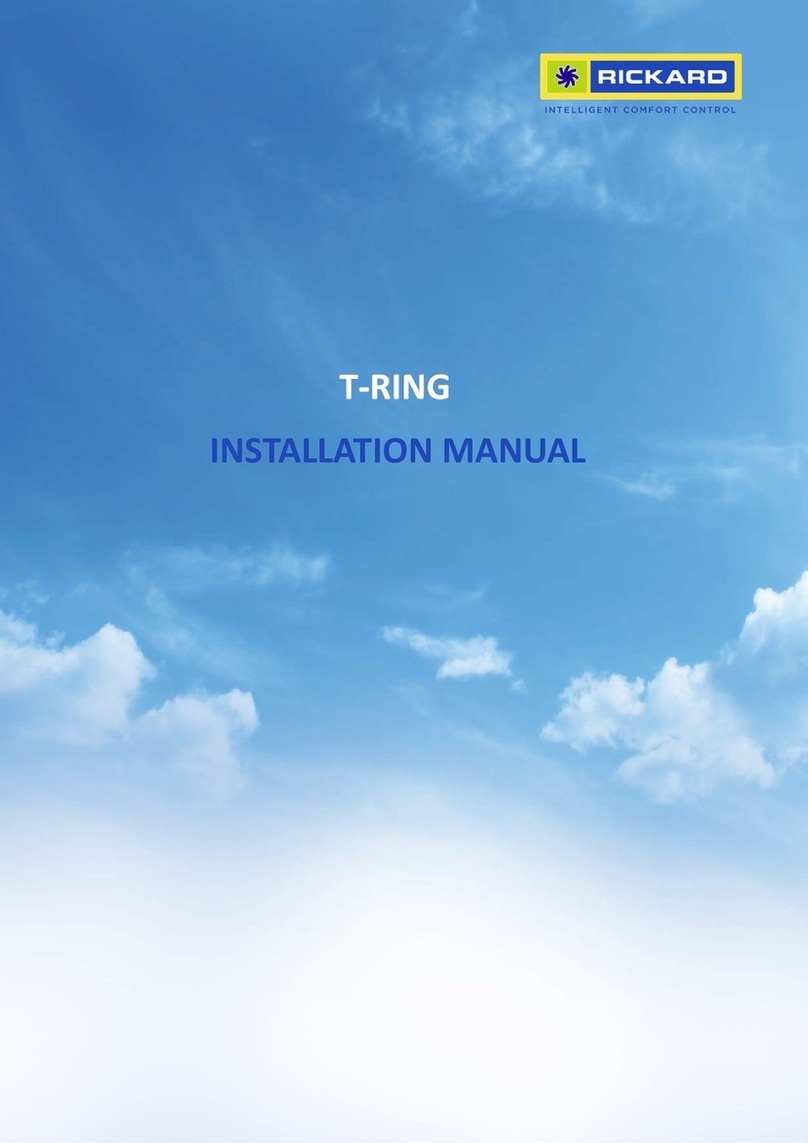INSTALLATION GUIDELINES
Your duct design should supply between 30 and 60Pa total pressure at each diffuser to ensure adequate flow across the heaters.
Please ensure the ducting is fitted with an airflow interlock/paddle switch that cuts the power to the electrical reticulation serving the
diffusers in the event of a loss of flow. This will ensure that the diffusers heaters are not energised when the AHU is off.
Rickard recommends a dedicated electrical outlet be fitted to the building heater reticulation and dedicated plug top be fitted to the
diffusers . This will ensure that the airflow interlock always cuts power to the diffusers heaters and not other equipment plugged into the
same circuit. This will also ensure that heaters are always plugged into a protected circuit.
Please see the “Electric Plug Ordering” Document for more details to order the correct plug top for your installation.
VCD
Recommended Heater sengs & sizing for a 15 Degree C Heat Rise @ 30% Open
Pa 20 30 40 50 60 70
Neck
Size
kW kW kW kW kW kW
Adjust Fit Set Adjust Fit Set Adjust Fit Set Adjust Fit Set Adjust Fit Set Adjust Fit Set
150 0.35 0.50 70% 0.34 0.50 68% 0.50 0.50 100% 0.50 0.50 100% 0.60 0.75 80% 0.65 0.75 87%
200 0.60 0.75 80% 0.70 0,75 93% 0.75 0.75 100% 0.90 1.00 90% 1.00 1.00 100% 1.00 1.00 100%
250 0.85 1.00 85% 1.00 1.00 100% 1.15 1.25 92% 1.30 1.50 87% 1.40 1.50 93% 1.50 1.50 100%
300 1.00 1.00 100% 1.25 1.25 100% 1.50 1.50 100% 1.65 2.00 83% 1.75 2.00 88% 2.00 2.00 100%
350 1.30 1.50 87% 1.50 1.50 100% 1.85 2.00 93% 1.85 2.00 93% 2.25 2.50 90% 2.50 2.50 100%
VSW
Recommended Heater sengs & sizing for a 15 Degree C Heat Rise @ 30% Open
Pa 30 40 50 60 70
Neck
Size
kW kW kW kW kW
Adjust Fit Set Adjust Fit Set Adjust Fit Set Adjust Fit Set Adjust Fit Set
150 0,35 0,5 70% 0,4 0,5 80% 0,45 0,5 90% 0,5 0,5 100% 0,55 0,75 73%
200 0,6 0,75 80% 0,7 0,75 93% 0,8 180% 0,85 185% 0,9 190%
250 0,85 185% 11,25 80% 1,1 1,5 73% 1,2 1,25 96% 1,3 1,5 87%
300 11100% 1,2 1,5 80% 1,35 1,5 90% 1,5 1,5 100% 1,6 280%
VLN1
2 Slot
Paern
C
Recommended Heater sengs & sizing for a 15 Degree C Heat Rise @ 30% Open
Pa 30 40 50 60 70
Length kW kW kW kW kW
Adjust Fit Set Adjust Fit Set Adjust Fit Set Adjust Fit Set Adjust Fit Set
600 0,3 0,5 60% 0,35 0,5 70% 0,35 0,5 70% 0,4 0,5 80% 0,45 0,5 90%
900 0,45 0,5 90% 0,55 0,55 100% 0,6 0,75 80% 0,65 0,75 87% 0,7 0,75 93%
1200 0,65 0,75 87% 0,75 0,75 100% 0,8 180% 0,9 0,9 100% 11100%
1500 0,85 0,85 100% 11100% 1,1 1,25 88% 1,2 1,2 100% 1,3 1,5 87%
WBD
Recommended Heater sengs & sizing for a 15 Degree C Heat Rise @ 30% Open
Pa 20 30 40 50
Size (mm) kW kW kW kW
Adjust Fit Set Adjust Fit Set Adjust Fit Set Adjust Fit Set
300/100 0,4 0,5 80% 0,5 0,5 100% 0,55 0,75 73% 0,6 0,75 80%
350/100 0,55 0,75 73% 0,65 0,75 87% 0,7 0,75 93% 0,75 0,75 100%
400/100 0,6 0,75 80% 0,75 0,75 100% 0,8 180% 0,9 190%
450/100 0,7 0,75 93% 0,8 180% 0,9 190% 11100%
500/100 0,7 0,75 93% 0,85 185% 0,95 195% 1,1 1,25 88%
550/100 0,75 0,75 100% 0,95 195% 1,1 1,25 88% 1,2 1,25 96%
600/100 0,9 190% 11100% 1,2 1,25 96% 1,25 1,25 100%
650/100 0,95 195% 1,15 1,25 92% 1,25 1,25 100% 1,45 1,5 97%
500/150 11100% 1,25 1,25 100% 1,6 280% 1,8 290%
550/150 1,2 1,25 96% 1,4 1,5 93% 1,65 283% 1,85 293%
600/150 1,4 1,5 93% 1,6 280% 1,9 295% 22100%
650/150 1,4 1,5 93% 1,7 285% 22100% 2,2 2,5 88%
700/150 1,5 1,5 100% 1,85 293% 2,2 2,5 88% 2,4 2,5 96%
800/150 1,75 288% 2,1 2,5 84% 2,5 2,5 100% 2,5 2,5 100%
To limit stratification in heating Rickard recommends that the heater outputs be limited to the values published in the tables above. The calculated values will
ensure that the heat rise is no more than 15°C in VAV diffusers and 10°C in CAV diffusers. Please note that these values are a guide and are calculated at 30%
volume for VAV diffusers and 100% volume for CAV diffusers. By adjusting the diffuser damper position down, a smaller volume will create a larger heat rise and
therefore increase the likelihood of stratification. The Fit column indicates the maximum fitted heater size recommended, the Adjust value indicates the maxi-
mum heater setting recommended to achieve a 15°C (VAV) or 10°C (CAV) heat rise and the Set column is the MLM Heater Output % value required to achieve a
15°C (VAV) or 10°C (CAV) heat rise.






















